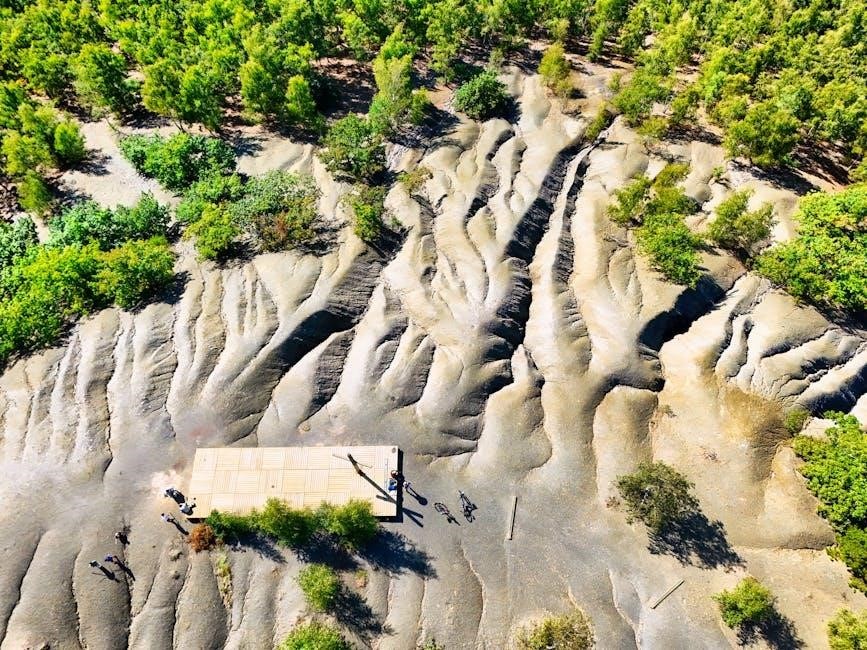This course explores human-environment interactions, spatial patterns, and global processes․ It introduces key themes like location, place, and movement, shaping our understanding of human systems and landscapes․
Overview of the Course
The AP Human Geography course is a college-level introduction to understanding human-environment interactions and spatial patterns․ It explores themes like location, place, movement, regions, and human-environment relationships․ The curriculum is structured around key subfields: economic, cultural, political, and urban geography․ Students analyze how humans adapt to and modify their environments, shaping landscapes and systems․ The course aligns with the College Board’s 2015 curriculum framework, ensuring a clear path for mastery․ It includes units on population, migration, cultural processes, political patterns, economic systems, and urban development, providing a comprehensive understanding of human geography․ Resources like PDF textbooks and online tools support learning and preparation for the AP exam․
Importance of Human-Environment Interactions
Understanding human-environment interactions is central to AP Human Geography, as it reveals how humans adapt to and modify their surroundings․ These interactions shape spatial patterns, influencing landscapes, cultures, and economies․ The course emphasizes the reciprocal relationship between human activities and environmental changes, such as deforestation, urbanization, and climate change․ Analyzing these interactions helps students grasp the consequences of human decisions on ecosystems and societies․ This knowledge is vital for addressing global challenges like sustainability and resource management․ By studying these dynamics, students develop a deeper appreciation for the interconnectedness of human and natural systems, fostering informed decision-making in an increasingly complex world․

Structure of the AP Human Geography Curriculum
The AP Human Geography curriculum is organized into six thematic units, each focusing on distinct aspects of human-environment interactions․ Unit 1 introduces foundational concepts like spatial reasoning and geographic tools․ Unit 2 explores population dynamics and migration patterns․ Unit 3 delves into cultural processes and landscapes․ Unit 4 examines political systems and territoriality․ Unit 5 covers economic development and globalization․ Finally, Unit 6 investigates urbanization and urban systems․ This structured approach ensures students build a comprehensive understanding of geography’s key themes, preparing them for the exam and fostering critical thinking about global issues․

What is AP Human Geography?
AP Human Geography is an interdisciplinary course exploring how humans interact with their environment, focusing on cultural, economic, political, and urban systems․ It bridges social sciences․
Definition and Scope
AP Human Geography is a college-level course that examines the relationships between people, places, and environments․ It explores how human activities shape and are shaped by the physical and cultural landscapes․ The course delves into key themes such as location, place, migration, culture, and regions, providing a holistic understanding of global patterns and processes․ By studying human-environment interactions, cultural diversity, economic systems, political structures, and urbanization, students gain insights into the complexities of our interconnected world․ This interdisciplinary approach prepares learners to analyze real-world issues, fostering critical thinking and geographic literacy․
Key Subfields: Economic, Cultural, Political, and Urban Geography
AP Human Geography encompasses four core subfields: Economic, Cultural, Political, and Urban Geography․ Economic Geography studies how people produce, distribute, and consume resources, shaping global trade and development․ Cultural Geography explores traditions, languages, and beliefs, highlighting diversity and cultural diffusion․ Political Geography examines the role of governments, borders, and conflicts in shaping territories and power dynamics․ Urban Geography focuses on city growth, urbanization trends, and challenges like inequality and infrastructure․ Together, these subfields provide a comprehensive understanding of human interactions with the environment, emphasizing the interconnectedness of economic, cultural, political, and urban systems in shaping our world․
Themes of Geography: Location, Place, Human-Environment, Movement, and Regions

AP Human Geography emphasizes five foundational themes: Location, Place, Human-Environment, Movement, and Regions․ Location refers to the precise position of a feature on Earth, while Place describes its unique characteristics․ Human-Environment Interaction explores how people adapt to and alter their surroundings․ Movement examines the flow of people, goods, and ideas across spaces․ Regions are areas defined by shared traits, such as culture or climate․ These themes provide a framework for analyzing global patterns and processes, helping students understand how people and environments shape our interconnected world․ A PDF textbook offers accessible insights into these themes, enhancing comprehension of their real-world applications․

Why Use an AP Human Geography Book in PDF Format?
PDF format offers portability, convenience, and cost-effectiveness․ Accessible on multiple devices, it enhances study flexibility and reduces environmental impact compared to traditional textbooks․
Accessibility and Convenience
An AP Human Geography book in PDF format enhances accessibility and convenience for students․ It allows learners to access course materials anytime, anywhere, without internet dependency․ PDFs are compatible with various devices, making it easy to study on smartphones, tablets, or laptops․ The format enables users to quickly search for specific topics, highlight important sections, and annotate pages digitally․ This convenience is particularly beneficial for students with busy schedules or those who prefer flexible study environments․ Additionally, PDF books save physical storage space, reducing the need to carry heavy textbooks․ Overall, the PDF format ensures that studying is more efficient and adaptable to individual learning preferences․
Cost-Effective Learning
Using an AP Human Geography book in PDF format provides a cost-effective learning solution for students․ Traditional textbooks can be expensive, while PDF versions often offer significant savings or are even free․ This format allows students to access comprehensive study materials without the financial burden of purchasing physical books․ Additionally, PDFs eliminate the need for shipping costs and reduce the risk of damage or loss associated with physical copies․ By utilizing digital resources, students can allocate their budget to other educational needs, making their learning experience more affordable and sustainable․ This cost-effectiveness ensures that high-quality educational materials are accessible to a wider audience․
Environmental Benefits of Digital Resources
Using an AP Human Geography book in PDF format offers significant environmental benefits․ By reducing the need for printed materials, digital resources help conserve trees and minimize deforestation․ Additionally, the production and transportation of physical textbooks contribute to carbon emissions, which are avoided with digital versions․ PDFs also promote sustainable learning by reducing waste and the environmental impact of shipping․ Students can access their materials anywhere without compromising the planet․ This eco-friendly approach aligns with the principles of sustainability, making digital resources a responsible choice for modern education․ Embracing PDFs supports a greener future while maintaining high-quality learning opportunities․

Course Structure and Key Topics
The AP Human Geography course is divided into six units, covering population dynamics, cultural patterns, political systems, economic processes, and urbanization․ It provides a structured approach to understanding human-environment interactions and global geographic processes․
Unit 1: Thinking Geographically
Unit 1 introduces foundational concepts in geography, emphasizing spatial reasoning and the tools geographers use․ Students explore key themes like location, place, and region, as well as human-environment interactions․ This unit also covers spatial concepts such as maps, scales, and geographic information systems (GIS)․ It lays the groundwork for understanding how geographers analyze data and patterns․ By mastering these skills, students develop a geographic perspective essential for addressing global challenges․ The unit emphasizes critical thinking and the application of geographic principles to real-world scenarios, fostering a deeper understanding of the world’s complexities and interconnections․
Unit 2: Population and Migration Patterns
Unit 2 delves into the dynamics of population and migration, examining how these factors shape human geography․ Students explore demographic concepts, such as population growth rates, age-sex pyramids, and theories like the demographic transition model․ Migration patterns are analyzed, including types of migration (voluntary vs․ forced) and push-pull factors influencing movement․ The unit also addresses the social, economic, and environmental impacts of population distribution and migration․ By studying these topics, students gain insights into how population dynamics and migration reshape cultures, economies, and political landscapes․ This unit is crucial for understanding global challenges like urbanization and refugee crises, using case studies and data analysis from the AP Human Geography book PDF․

Unit 3: Cultural Patterns and Processes
Unit 3 explores the diverse ways cultures shape and are shaped by their environments․ Students examine key concepts like cultural traits, language, religion, and ethnicity, and how these elements influence identity and place․ The unit emphasizes cultural diffusion, including how ideas, technologies, and practices spread across regions․ It also addresses globalization’s impact on cultural homogenization and diversity․ Case studies and maps from the AP Human Geography book PDF highlight examples such as linguistic landscapes and religious patterns․ Understanding these processes helps students analyze how cultures adapt and evolve, shaping human interactions with the environment and each other in complex ways․
Unit 4: Political Patterns and Processes
Unit 4 focuses on the spatial organization of political systems and their impact on human geography․ Students explore concepts like territoriality, sovereignty, and governance, analyzing how political boundaries shape identities and conflicts․ The unit covers types of states, such as nation-states and city-states, and examines geopolitical theories․ It delves into the role of international organizations and the challenges of political fragmentation․ Using the AP Human Geography book PDF, learners study how political processes influence regions and global interactions․ Mapping and case studies help illustrate the complex relationships between power, territory, and resources, preparing students to understand modern geopolitical dynamics and their implications for societies worldwide․
Unit 5: Economic Patterns and Processes
Unit 5 delves into the spatial patterns of economic activities and their impact on societies․ It explores various economic systems, including capitalism, socialism, and communism, and examines how globalization shapes trade and labor markets․ The unit covers primary, secondary, and tertiary industries, highlighting regional specializations and economic inequalities․ Students also study the role of corporations, technology, and resource distribution in shaping economic landscapes․ Using the AP Human Geography book PDF, learners analyze case studies of economic development and underdevelopment, gaining insights into how economic processes influence human well-being and environmental sustainability․ This unit equips students with tools to understand the interconnected global economy and its spatial variations․

Unit 6: Urban Patterns and Processes
Unit 6 focuses on the dynamics of urbanization and the spatial patterns of cities․ It examines how urban areas develop, function, and influence surrounding regions․ Topics include urbanization trends, models of urban structure like the sector and multiple nuclei models, and the role of transportation in shaping cities․ The unit also explores urban challenges such as overcrowding, poverty, and environmental degradation․ Using the AP Human Geography book PDF, students analyze land-use patterns, suburbanization, and urban planning strategies․ This unit helps learners understand the complexities of urban life and the role of cities in economic and cultural development, preparing them to address real-world urban issues effectively․

Resources and Study Tools
The AP Human Geography book PDF offers comprehensive study materials, including interactive maps, diagrams, and practice questions․ Online platforms like AP Classroom and Quizlet provide additional support, while free-response questions and practice tests help students assess their understanding effectively․
AP Classroom and Online Platforms
The College Board’s AP Classroom provides personalized resources, progress tracking, and access to question banks tailored to the AP Human Geography curriculum․ Online platforms like Khan Academy and Coursera offer supplementary video lessons and interactive exercises․ These tools complement the AP Human Geography book PDF by providing dynamic learning experiences․ Students can engage with digital flashcards, practice quizzes, and discussion forums to reinforce concepts․ Additionally, online platforms often include teacher support and peer collaboration opportunities, fostering a community of learners․ Integrating these resources with the PDF textbook creates a well-rounded study environment, ensuring students are well-prepared for exams and deeper understanding of the subject․
Quizlet for Vocabulary Building

Quizlet is an invaluable tool for mastering the vocabulary essential to AP Human Geography․ It offers digital flashcards, tests, and study games tailored to key terms and concepts․ Students can create custom sets or use pre-made ones aligned with the AP curriculum․ Interactive activities promote active recall and spaced repetition, enhancing long-term retention․ Quizlet complements the AP Human Geography book PDF by providing a dynamic way to engage with terminology․ Its mobile app ensures learners can study anywhere, making it a flexible resource for building a strong foundation in geographic vocabulary․ This tool is particularly useful for preparing for exams and understanding complex concepts more deeply․
Free Response Questions and Practice Tests
Free response questions (FRQs) and practice tests are crucial for preparing for the AP Human Geography exam․ These resources help students understand the exam format and refine their critical thinking and writing skills․ Practice tests simulate real exam conditions, reducing anxiety and improving time management․ FRQs focus on applying concepts to real-world scenarios, enhancing analytical abilities and essay-writing techniques․ Utilizing these tools alongside an AP Human Geography book PDF ensures comprehensive preparation․ They allow students to identify strengths and weaknesses, enabling targeted studying․ Regular practice with FRQs and tests builds confidence and readiness for the actual exam, ensuring students perform at their best․
Final Thoughts on the AP Human Geography Course
The AP Human Geography course is a transformative learning experience that equips students with critical thinking and analytical skills to understand global patterns and processes․ By exploring themes like location, place, and human-environment interactions, students gain a deeper appreciation for the complexities of our interconnected world․ The course fosters a holistic understanding of cultural, economic, political, and urban systems, preparing learners for real-world challenges; Leveraging resources like the AP Human Geography book PDF enhances engagement and accessibility, ensuring students can master the curriculum effectively․ Embrace the journey, stay committed, and utilize these tools to excel in your academic and future endeavors․
Encouragement for Students to Utilize PDF Resources
Embracing digital learning tools, such as the AP Human Geography book PDF, is a smart way to enhance your study experience; PDF resources offer unparalleled convenience, allowing you to access materials anytime, anywhere, and on multiple devices․ They are also environmentally friendly, reducing the need for physical books․ Additionally, PDFs often include interactive features like annotations and highlighting, which can boost your engagement and understanding․ By utilizing these resources, you can streamline your studying, stay organized, and maximize your preparation for exams․ Make the most of this flexible and efficient learning format to achieve success in your AP Human Geography journey․




